Bristol, being a port, has always had links with the colonies and especially America. Giles Penn, who came from Redcliffe, was a seafarer, his son, William, was born in 1621, and was to become an admiral. He was later knighted for his services to Charles II. William lent huge sums of money to King Charles and on his death in 1670 his son, also named William, and who had become a Quaker, asked the king for repayment. Rather than ask for money, William asked for a grant of land in America to establish a Quaker colony. King Charles agreed so long as the land was called Penn in honour of his trusted admiral. Hence the birth of Pennsylvania. Admiral Penn is buried at the entrance of the south transept.
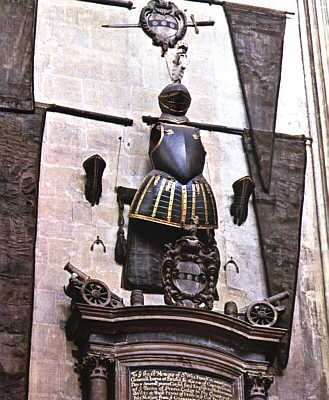
The Armour of Admiral Sir William Penn
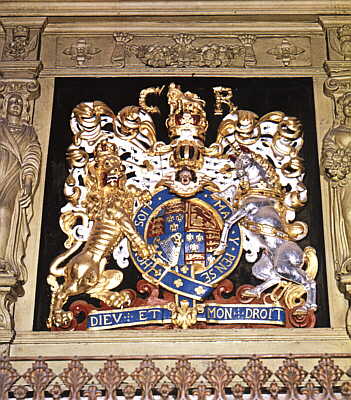
The Arms of King Charles II
A Royal Proclamation of 1660 ordered that all parish churches display the royal arms. St Mary Redcliffe has one of the few remaining examples. It was around this time that the church must have been a very noisy place as 20 Chantry Priests held office here. They were charged with looking after their own separate chapel or altar around the church and as such there were many different services being held at the same time. A Chantry priest was often paid for by a wealthy family to offer continual prayers for them.
Thomas Chatterton was born in nearby Pile Street in 1752. In 1767 he became apprenticed to a Mr Lambert, a lawyer in Corn Street, as a scrivener. A scrivener was someone who copied legal documents in a fair hand. Although a gifted poet, in 1768 he sent a document to Felix Farley's Journal purporting to be an original account of the opening of Bristol Bridge in 1248. Later when working in the muniment room at St Mary's he claimed to have found some poems written in the 15th Century by Thomas Rowley. In the end Mr Lambert dismissed him from service as he had found a document by Chatterton that purported to be his (Mr Lamberts) last will and testament. Chatterton left for London where he took his own life, aged only 17, through taking arsenic in 1770. Some people dispute that Chatteron deliberately meant to take his own life. In March 2004, Tom Routledge emailed me, telling me of the Thomas Chatterton Society and saying that he
"probably overdid his dosage of laudanum and arsenic while treating his venereal disease - a common thing for the youth of his day. The fact that he was half-starved at the time lowered his resistance and he died in London - before he was 'discovered'. He became the prototypical 'ignored genius' and 'artist, starving in a garret' in the following Romantic Era of English poetry and literature."
Whatever his end, the sad thing is that, despite the frauds he committed early in his life, he was a very good poet with the likes of Wordsworth, Shelley and Keats singing his praises. As Wordsworth said in his 1807 poem "Resolution and Independence"...
I thought of Chatterton, the marvellous Boy,
The sleepless Soul that perished in his pride;
Of Him who walked in glory and in joy
Following his plough, along the mountain-side:
By our own spirits are we deified:
We Poets in our youth begin in gladness;
But thereof come in the end despondency and madness.
In 1840 a statue of him wearing his school uniform was erected in the grounds of St Mary's.
Near to Chatterton's statue, set in the grass, is a small gravestone. Engraved in this are the words The Church Cat 1912 - 1927.
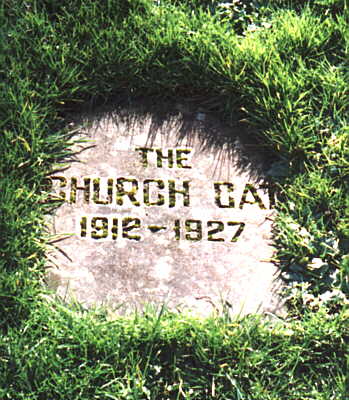
The gravestone of Tom - the church cat
In 1912 a tabby kitten was found by the priest's door. It was thought he was attracted by the music of the organist, Mr Ralph Morgan. For the next 13 years Tom was looked after by the Verger, Mr Eli Richards, who died in 1925. Tom kept the numbers of pigeons around the church down and by the account I've got, was also a great mouser. When the altar cross was removed in 1920 three bathfulls of feathers and bones had to be removed with it, all carefully hidden by Tom. Tom would process through the church with the choir and would sit by the organist for the service. The blind organist, Mr Alfred Hollins, who was born in Hull in 1865 and who died in Edinburgh in 1942, mentions in his reminiscences that the cat would often sit beside him. Sometimes Tom would sit on the lap of one of the congregation. After Eli Richard's death Tom was looked after by Ted Richards until 1927 when Tom died.
In September 2002, I received an email from Nick Richards. Mr. Richards writes :-
Eli Richards was my great grandfather and after his retirement as Verger, my grandfather Edward Richards took over. To the best of my knowledge Edward has never been known as Ted. However My father, Edward Earnest Walter Richards born 1916 (known as Ted Richards), became Verger upon the retirement of Edward Richards (my grandfather), who then became "the custodian" of the church.
As a family we have many pictures of Eli with the church cat, who was more famous for his rat and mouse catching than catching pigeons.
Tom had the distinction of attending more services than any of the clergy and on his death was given a grand funeral to the accompaniment of church music, and attended by the Verger, Vicar and Wardens.
At the annual Redcliffe community fair held in the church grounds one of the attractions is to see brave teddy bears bungee jumping from the roof.
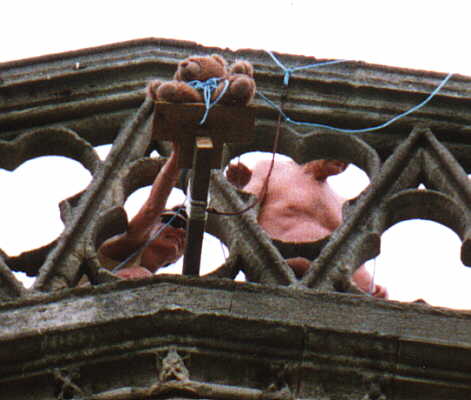
Another brave teddy preparing for the thrill of a lifetime
These dare-devil bears plummet over 30 feet towards the flag-stones before having their fall broken by a frail piece of elastic. This year (2001) there was a heart-stopping moment when the elastic was too long and one of the fearless teddies hit the stonework head first, but he quickly recovered and was soon in the queue for another go!!!
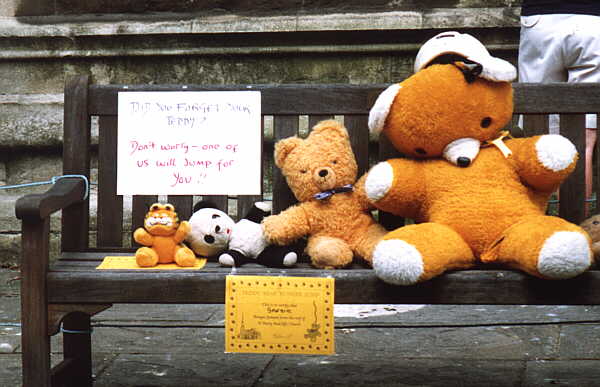
A handful of Extreme Sport teddy bears
The children these bears belong to ask the bears if they are nervous or if they may get hurt. One little boy asked if his puppy could have a go, but was politely told it was for teddy bears only.
In Colston Parade, just to the south of the church is a house dating from 1784. This is Fry's House of Mercy.
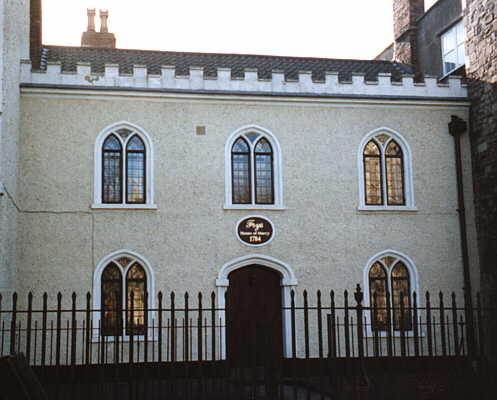
Fry's House of Mercy ~ 1784
One of the great industries of Bristol is chocolate making. In 1731 Walter Churchman was granted a patent for an 'engine' for the making of chocolate. On his death in 1761, an apothecary, Joseph Fry took over the business. I don't know whether this family has any connection with the house, or indeed of Mrs Roderick Fry who spent eight years during the 1930's making the vestments for St Mary's. Another family connected with chocolate, the Quaker Cadbury family, also helped generously with the upkeep of the church.
This page created 24th February 2000, last modified 24th January 2016